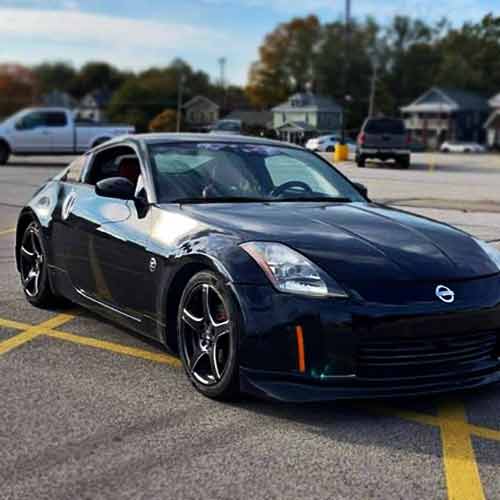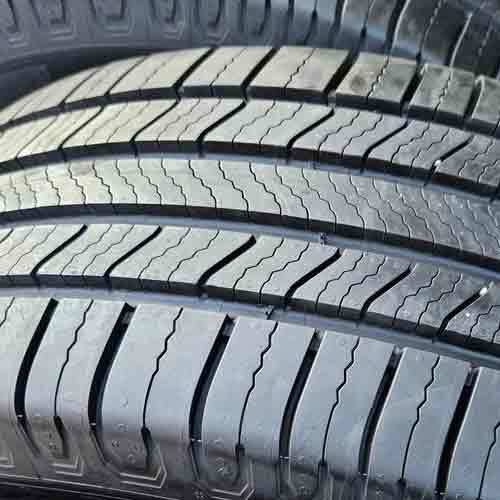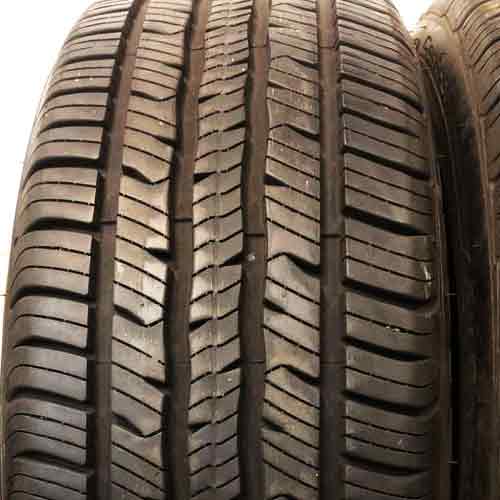The BF Goodrich Advantage Control comes in the Grand Touring All-Season category, while the Michelin Defender 2 is a standard touring tire. Both of these offer dependable year-round traction combined with durability. But which is better? Well let’s find out.

Key Takeaway
So overall, the BFG Advantage Control comes with superior directional grip, wet traction, and enhanced winter performance thanks to its softer rubber and better siping structure. In contrast, the Michelin Defender 2 leads in dry grip and steering responsiveness, tread longevity, better fuel economy through reduced rolling resistance, and quieter rides owing to it’s J-shaped grooves on sidewalls.
Diverse Sizing and Specs
The Michelin Defender 2 comes in 16 to 20″ inches rims, having following specs.
- Speed ratings: H (on all)
- Load ratings: SL and XL
- Tread depth range: 10.5/32″ (on all)
- Weight range: 25 to 32 lbs
- Winter ratings: Only M+S no 3PMSFR.
- Tread mileage rating: 85k miles.
- UTQG rating: 800 A A.
Review this tire in greater details: https://tiredriver.com/michelin-defender-2-review/
The BF Goodrich Advantage Control Review comes in 14 to 20 inches rims, and they have the following specs.
- Speed ratings: H, V and W.
- Load ratings: SL and XL.
- Tread depth range: 10.5 to 11.5/32″.
- Weight range: 17 to 32 lbs.
- Treadwear warranty: 75k miles for H, or 65k miles for V and W speed rated sizes.
- UTQG rating: 700 B A.
Review this tire in greater detail: https://tiredriver.com/bf-goodrich-advantage-control-review/
Tire Structure
The Michelin Defender 2 showcases a symmetric pattern that is distinctly streamlined.

Now it’s tread is divided in to 5 sections, which are block columns, called ribs, in the tire world.
And speaking of outer two of these “ribs”, they appear notably minimalistic compared to its middle.
They primarily consist of lateral grooves and a simple interlocking siping structure.
While in contrast, the three central ribs, delineating four longitudinal channels, are densely filled with siping.
This goes especially for the middle most rib (which is also continuous running).
Though the adjacent ribs have extra biters, (referring to the lateral voids they make).
Internally, the Defender 2 is equipped with a single-ply polyester casing, reinforced with two steel belts and complemented by a nylon cap ply.
Moving towards the BF Goodrich tire, you get a very similar design.

Like the Defender, you also see 5 rib design here, and a symmetric tread pattern.
And in a similar manner, you get a continuous running rib, right in the middle.
Though it’s laced with more biters, where notches point towards both sideways directions, and joining them are thick siping slits.
Similarly, the outer ribs carry similar features, though they have slightly more pronounced shapes.
The outer two shoulder ribs are open, however, as they make proper lateral voids in between.
Moreover, they don’t carry any notches and are only seen with linear sipes.
Internally, the tire consists of a dual-ply lightweight polyester layer. Fortifying this are two steel belts, and atop them lies a nylon cap ply, bolstering the tire’s central durability.
Side Note: Before getting into the performance of each tire, it’s important to note that I only compared sizes with H speed ratings. The Defender 2, being a standard touring tire, offers ratings up to H, while the BFG, as a Grand touring tire, goes up to V. Comparing both with similar ratings ensures a more accurate comparison, as I aim to keep all variables consistent when evaluating tires.
Winter Performance
Evaluating an all-season tire’s winter proficiency hinges on:
- Acceleration.
- Handling, (where particularly steering responsiveness matters the most).
- And tire’s versatility across terrains, emphasizing performance on soft snow and ice.
Now let’s me start off by saying that both tires aren’t great options here, and there are far better options in both standard and grand touring categories, of all season tires (where these two belong).
Nonetheless, my testing with these tires show that the BF Goodrich Advantage Control still has the upper hand, mainly due to it’s relatively softer rubber compound, and more effective siping.
First off, it’s rubber is more thermally adaptive, so with freezing environment, its biters still remain more flexible comparatively.
Moreover, it features thicker siping, (which also connect to sideways facing notches), and these are more effective in biting snowy terrains.
Note: Both tires don’t come with 3 Peak Mountain Snowflake ratings, but they do have M+S.
Tread Longevity
The longevity of tire tread is determined by several key factors. These include, tread compound/design/depth along with weight.
Now here, although both tires weigh similar compared to each other, the overall wear rate on BF Goodrich Advantage Control is greater.
But why?
Well this has to do with Defender 2 offering Michelin’s MAX Touch and EverTread technologies.
The MaxTouch feature ensures a more efficient distribution of the tire’s weight, allowing for smaller rolling resistance generation. And the Evertread compound contains specific polymers enhancing its resistance to cuts.
That’s why you get one of longest lasting tire, (in standard touring category), where you get treadwear warranty of 85k miles.
Highway Performance
Both tires showcase proficiency in multiple areas, including dry traction, steering accuracy, and stability at high velocities.
Let me explain them all.
Directional Grip
Directional grip primarily involves the tire’s center tread, since its gathers the most weight, while the tire maneuvers in a straight line. So consequently, these central lugs/ribs make the most contact with the road.
That’s why both tires have continuous running ribs in the middle, which allow them to maintain consistent contact with the asphalt, at all times.
Though overall, the BF Goodrich Advantage Control still has the upper had here, despite it’s ribs having more pronounced voids in them.
So how is it better?
Well, Interestingly, these voids although take away the rubber, (that could have been in contact with the road), they functioning as in-groove notches, are still able to provide you with “more” grip, in return.
That’s why BFG have sizes, with speed ratings going up to W, whereas the Defender 2 only goes up to H. (Greater the speed rating, greater the grip).
On the other hand, while the Michelin Defender 2 although features a sleek design in its middle, providing excellent results when it comes to its standard touring category, it falls short here, with missing ample biting edges.
Nonetheless, you should know that the performance difference between both tires, is pretty low, almost less than half feet, in terms of their averaged braking distances. (Braking is the direct measure of directional grip).
Dry Grip and Steering
In handling, both tires, possessing similar rubber-road contact, deliver almost identical lateral traction, (saying this from their calculated similar g-force readings, on tests).
But grip alone doesn’t tell the complete story, and you have to add in the steering responsiveness factor too. And that’s where the Michelin edges ahead, giving out faster handling feedback.
The Defender 2 takes the lead (literally), by over a second, compared to BFG’s tire on (lap time) tests.
And it’s superior performance is credited to it’s lighter construction, for the most part, which means that its tread lugs experience reduced weight pressure when interacting with the road, limiting lug flex.
On the other side, the BF Goodrich Advantage Control tire coming in grand touring category, comes up with a softer relative rubber composition, which although allows it to have more comfort, also makes its lugs more susceptible to bending, in comparison.
Moreover, it’s greater tread depth on average is also helping it here as well.
But why lug bending affects handling?: When tire lugs flex, they take “time” to return to their original form. This time literally adds up to the overall handling time. That’s one way to put it, hope you’d get it.
Wet Traction
Wet traction gets complicated, because of a single fact that water is not compressible. This means it has to go out (of the tread), otherwise, it would come in between, and cause tire to float or hydroplane.
This underscores the significance of sipes and grooves in tires, which serve as water cleaning elements.
Here groove offer direct pathways for water to leave out, while sipes come in later (literally) sucking up remaining particles inside their slits (as they create suction by flexing).
Now, while neither tire excels remarkably in wet conditions, the BF Goodrich Advantage Control edges ahead. It manages to consistently outperform Defender 2, thanks to its superior full-depth siping structures, coupled with it’s softer tread compound.
Whereas the Michelin’s tire lacks and demonstrates noticeable slippage, largely attributed to its less effective siping. I mean, sure, it has a lot of interlocking sipes, but the thing is, with the tire’s rubber being a lot more stiffer, they don’t flex enough, or create enough suction for water particles.
Furthermore, the closed-off shoulders of the Michelin Defender 2, with interspersed ridges, hinder efficient lateral water evacuation too. So less water gets out (through grooves, initially), and there’s more burden on sipes to begin with relatively.
In contrast, if you examine the BF Goodrich Advantage Control’s tread (consider it’s design again, by scrolling up), you’ll note that it has more spacious shoulder blocks. This design facilitates a more effective water dispersal, enhancing the tire’s overall wet performance.
Fuel Economy
Fuel efficiency is influenced by factors such as tread composition, tire weight. Actually both of these factors (predominately) affect the tire’s rolling resistance, which is directly proportional to fuel consumption.
Having said that, it makes sense why the BF Goodrich Advantage Control falls behind here. The tire although offers more grip (and along with it greater speed ratings), it comes at a cost (literally), as it reduces economy, with it’s higher rolling resistance values (calculated on average).
On the other side, the Michelin Defender 2 with it’s Max Touch technology evenly distributes it’s weight pressure points among its lugs, and it’s shallower tread depth (and less biters throughout its tread), keeps it’s ribs more streamlined.
These characteristics minimize lug flexing, ensuring energy is channeled primarily into the tire’s rotation instead of being wasted as heat or in tread deformation.
The outcome? Well, you get better mpg readings on Michelin’s tire.
Noise Dampening Ability
Tire noise primarily originates from the interaction of air particles with the tread walls. As a tire rolls, air infiltrates, mainly through the shoulders, and impacts the tread, producing noise.
Given this mechanism, it’s clear why the BF Goodrich Advantage Control, with its more open structure, doesn’t excel in noise reduction.
And this goes especially when compared to Defender 2, where the Michelin offers you a much quieter ride, emitting a subtle hum that blends effortlessly with ambient sounds.
This is basically attributed to its J-shaped shoulder/sidewalls grooves.
These grooves, combined with shoulder ridges (blockers in shoulder voids), limit air infiltration, and allow for varied collision points for air.
The result is a spectrum of sound frequencies that counteract each other, leading to reduced noise.
Conclusion
In the comparison of the two tires, it becomes clear that each possesses distinct strengths.
The BFG Advantage Control comes on top in:
- Directional grip with its unique in-groove notches providing enhanced traction.
- Wet traction, due to its full-depth siping and spacious shoulder blocks which facilitate better water dispersal.
- Winter performance, as the softer rubber compound and thicker siping offer better flexibility and snow terrain bite.
While the Michelin Defender 2 takes the lead in:
- Dry grip and steering responsiveness, thanks to its lighter construction and quicker handling feedback.
- Tread longevity, with the inclusion of MAX Touch and EverTread technologies.
- Fuel economy, as its design minimizes rolling resistance, leading to better miles per gallon.
- Noise dampening ability, thanks to it’s compacted up shoulder blocks.